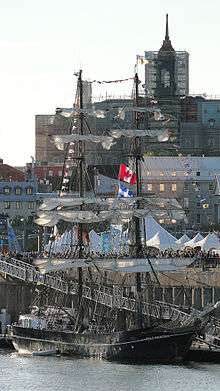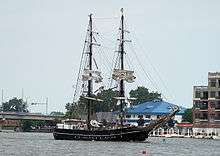Roald Amundsen (ship)
 Roald Amundsen at the Kiel Week 2007 | |
| History | |
|---|---|
| Name: | Roald Amundsen |
| Operator: | Lebenlernen auf Segelschiffen e.V. |
| Launched: | 1952 |
| Renamed: | 1992/1993 |
| Refit: | In 1992-1993 as a brig |
| Homeport: | Eckernförde, Germany |
| General characteristics | |
| Displacement: | 480 |
| Length: | 50,2 m overall; hull: 38.2 m |
| Beam: | 7.2 m |
| Draft: | 4.2 max. |
| Propulsion: | 300 PS (221 kW) Buckau-Wolf |
| Sail plan: | brig (18 sails = 850 m²) |
| Crew: | 16 regular crew + 32 trainees |


Roald Amundsen (often abbreviated Roald; named in honor of Norwegian polar explorer Roald Amundsen), originally named Vilm, is a German steel-ship built at the Elbe River in 1952. Having worked in different areas, she was refitted in 1992 to 1993 as a brig (two-masted square-rigged sailing ship) and now serves as a sail training ship. During summer, she usually operates in the Baltic Sea, and usually embarks for journeys to farther destinations for winter, including several trans-Atlantic crossings.
Ship history
The hull of the ship was built at the shipyard Roßlauer Werft at the Elbe River in Roßlau, German Democratic Republic, in 1952. Originally intended for fishing as a deep sea fishing lugger, plans were changed before the completion of the ship, and she was then instead built as a type of tanker, receiving her final completion at the shipyard Peene-Werft in Wolgast, Germany, at the shore of the Baltic Sea.
Named Vilm, the ship was put to use for the National People's Army (NVA), first as a tanker and supply vessel, operating out of Peenemünde and crewed mainly by civilian seamen. Converted to a transporter for bilge water in the 70s on the Peene-Werft, the Vilm then made regular trips to the bases of the National People's Army to take the ships' bilge water to a centralized treatment facility. This service was discontinued at the end of 1988.
After not having been used for a year, the Vilm was towed to Neustadt in Holstein and there at the navy base used as living quarters. At the beginning of 1991, the ship was put up for sale by the Vebeg GmbH, a corporation to sell federal property.
Detlev Löll and Hanns Temme bought the ship at an auction and, with the help of some of the former crew, sailed the ship to Wolgast in Mecklenburg-Vorpommern. In spring 1992, a complete overhaul began, in the course of which the ship received a new exterior keel and was refitted as a brig; the rig includes five square sails at each mast and includes lifting yards for the upper-three yards (upper main topsail, topgallant and royal) at each mast, lowering the center of gravity of the ship when sails are furled. The overhaul was subsidized by the state of Mecklenburg-Vorpommern and the Bundesagentur für Arbeit and formed part of the job creation program „Fridtjof Nansen“ (led by the owner), which comprised the refitting of this ship as well as the Fridtjof Nansen and the Nobile.
In 1993, the ship was put to its new use under the name of Roald Amundsen. It was chartered by the newly founded sail training club „LebenLernen auf Segelschiffen e.V.“ (short: LLaS; German: learning to live on sailing ships). After a short intermezzo with another sail-training club, „Segelschiff Fritjof Nansen e.V.“, in 1993, the Roald Amundsen has since been chartered by the LLaS and used for sail training.
Roald Amundsen now operates all year around as a sail training vessel with voyages lasting between one and three weeks. Her home port is Eckernförde, a harbour city in Schleswig-Holstein near Kiel in northern Germany. Summer months are spent with voyages on the Baltic Sea from Denmark to Baltic countries or the North Sea. Winters are spent in warmer regions. The Roald Amundsen has repeatedly crossed the Atlantic Ocean, bound for South American ports in Brasil and French Guiana (1998), for tall ships events in North America (2000, 2010), and for the Caribbean (2001, 2011/12, 2012/13). Further destinations include Iceland (1995), England and Ireland (2006), the Mediterranean (2006/07, 2007/08), the Canary Islands (1995), and others. During her North American voyage in 2010, the Roald Amundsen visited the Great Lakes and there met with the US brig Niagara; the two brigs formed an unofficial friendship, and as of 2013, the Roald Amundsen still flies a flag of the Niagara at some occasions such as the Tall Ship Parade at Kiel Week.
The ship has participated in the Tall Ships' Races and is rated as a Class A tall ship by Sail Training International.[1]
Specifications
Length over all: 50,20 m
Length of hull: 40,80 m
L.W.L. (Length of waterline): 38,20 m
Width/beam: 7,20 m
Draft: 4,20 m
Mast total height: 34,00 m
Sail Area: 850,0 m² (square meters)[with 18 sails]
Crew: 31 Trainees plus Crew quarters [17 Regular Crew]
Motor: 300 PS (220 kW) 8-cylinder (Buckau-Wolff Diesel motor)
Generators: 1x 48 kW; 1x 53 kW
Displacement: 480 t
GRT: 298
ballast: 180 t
ballast tanks: 108 t
call sign: DARG
MMSI: 211215170
IMO No: 8994489
STAG-Sail-No: TS G 508
Ensign / flag: Germany
Equipment: Radar, echo sounder, Global Positioning System, Automatic Identification System, magnetic compass, LRC Long Range Radio, EPIRP-buoye, Inmarsat, short wave radio, Life Rafts, Zodiac, personal safety equipment (rescue vests etc.)
References
External links
| Wikimedia Commons has media related to Roald Amundsen (ship, 1952). |